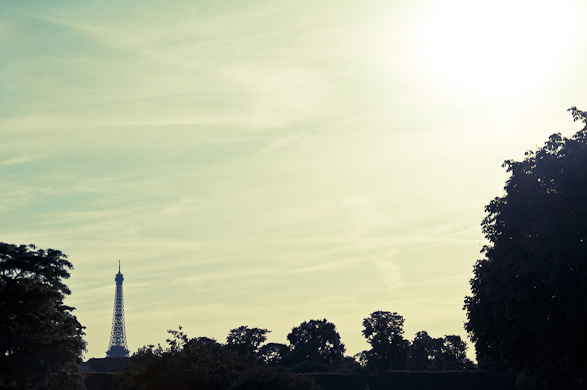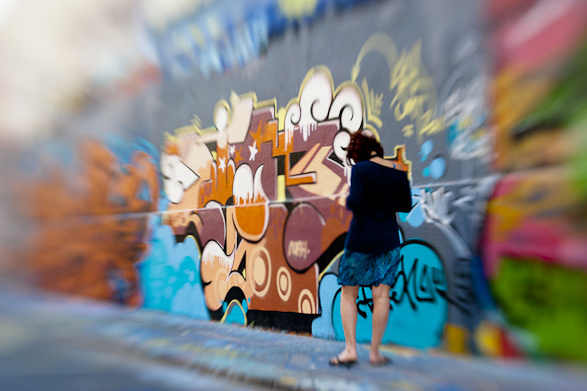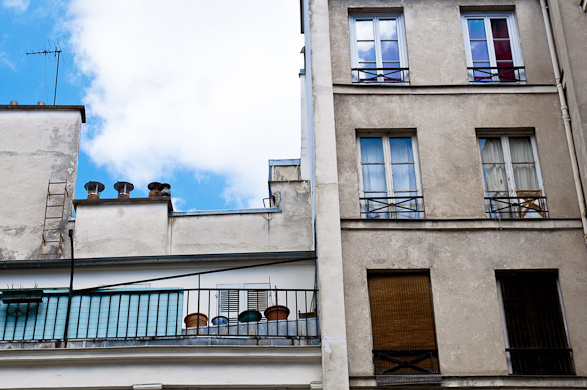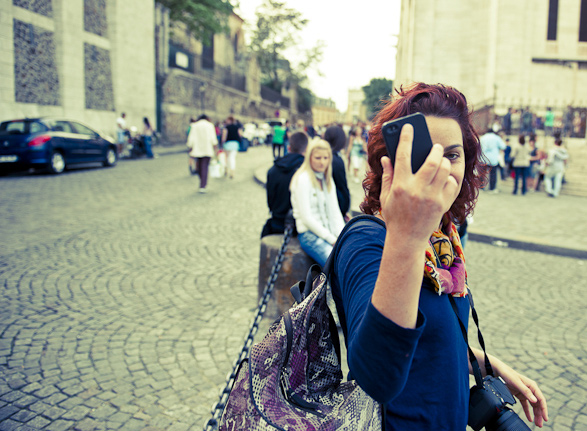
My first visit to Paris was actually a mad chase after all the touristic attractions and the ‘must-see’, ‘must-go’, ‘must-do’ places: I saw the Tour Eiffel sparkling at night, walked along the Champs-Élysées, all the way to Arc de Triomphe , climbed the steep streets of the Montmartre and sighed when I saw the beauty of the Basilique du Sacré-Cœur. I paid a visit to the old cemetery of Montparnasse and looked for Jean Paul Sartre and Samuel Beckett’s graves. I Photographed the Mona Lisa in the Louvre, along with hundreds of people, searched for the old synagogue in Le Marais and drank coffee in the famous Café de Flore in Boulevard Saint-Germain. I visited Centre Pompidou and for shopping I went to Gallery Lafayette. If this was not enough, I also French kissed while looking over the Notre Dame.
All of this happened twelve years ago, when I visited Paris by myself for the first time and indulged myself in the touristic Parisian days and night. I was a student on summer break. What did I know….



But my second and third visits to Paris were completely different. I was already a ‘well-travelled’ person who is more curious about how the locals live than how the tourists spend their days and I did so many other things. I called these visit ‘Paris for the Advanced Users’. Paris for the Advanced Users is for those who had already been to Paris at least once — and for those who prefer discovering a city while taking the side streets and not following the touristic path.
If you are an advance user, or want to be one, here are few places worth checking.
La Butte aux Cailles: A small Parisian neighborhood, located on the hills of the 13th Arrondissement. The neighborhood was originally a fenced village outside Paris that was annexed to the city in 1860. It is characterized by mostly small, low-rise buildings in an Art Nouveau style, similar to the traditional buildings in northern France and Russia.
Some of the buildings have small courtyards, which are open to the public during daylight hours and locked after dark. The uniqueness of this neighborhood is characterized by its narrow streets and cobblestone roads around small squares, which once served as a central meeting place in the village. In Place Paul Verlaine you can find an active and natural spring water source; you can even drink from it and it also serves as a natural source of water to the other fountains in the neighborhood’s courtyards. The neighborhood that once was inhabited by working-class people, has now become extremely popular among young artists, and it attracts wealthy residents who appreciate the charm and the artistic non-metropolitan atmosphere of the place. If you are not looking for touristic attractions, then this is the place for you.
You should visit the neighborhood in the afternoon, walk around the galleries and the courtyards and end your evening at a local restaurant bustling with Parisians of all ages, and where waiters don’t know a word of English.
Directions: Get off the Metro line 6 at Corvisart and go up the Rue des Cinq Diamants until getting to the heart of the neighborhood at Rue de la Butte aux Cailles.



BNF: Bibliothèque Nationale de France: The National Library of France is located in Tolbiac area in the 13th Arrondissement as well. It is considered the largest and most important library in France. The original location was in Rue de Richelie in the 2nd Arrondissement from 1720 until it was moved to the current site, (also called the Francois Mitterrand site) in 1996. Mitterrand gave the library a legal status of public institution in 1988 and turned it into one of the most important and advanced libraries in the world.
The site consists of four towers; Tower School, Tower Court, Wind Tower and Tower Time, and its architecture resembles a book holder and — when seen from above — it resembles an open book. The quantity of the books is immense; 10 million documents and writings, spread over an area of over 420 miles of bookshelves. Visiting the library is both an architectural and intellectual experience. It is worth paying the fee to get into the reading rooms and see the interior of the building. The site is even more spectacular and impressive in the evening, when the buildings are lit up.
Directions: Get off the Metro line 14 at Bibliotheque Fr . Mitterrand.
Place de la Nation: A square, situated on the border between the 11th and the 12 Arrondissements, has a great monument of Marion, one of the national symbols of the French Republic, as she stands on the globe in a carriage drawn by lions. The monument, which symbolizes the triumph of the Republic, was established to mark the 100th anniversary of the French Revolution. The adjacent streets will lead you to a colorful area with walls covered in frequently changing graffiti.
Directions: Get off the Metro line 6 at Nation.




Ecole Nationale supérieure des Beaux Arts: The National Superior School of Art, also called ‘The Bazar of Paris’, is considered one of the world’s most prestigious schools for art. It is located on rue Bonaparte, in the middle of the Saint-Germain-des-Prés district, which is filled with art galleries, furniture stores and interior design studios. There is no better place for the school to be located; if the students ever need an inspiration, they can always cross the Seine and head straight to the Louvre.
The school was established in 1648 and includes a complex of four buildings around a courtyard patio dotted with sculptures. Although the school entrance is reserved for students and faculty members only, you can get an organized tour with a guide from the school on Mondays. It is a great and fascinating way to absorb art that’s a little bit different than going to a museum.
Directions: Get off the Metro line 12 at Rue du Bac and continue until you get to Rue de L’ Universite. Turn right until you reach the intersection of Rue Bonaparte. Entrance is at number 14.



Canal Saint Martin: Canal Saint Martin is a combination of the old Paris and the new one. There are many little cafe’s along the canal next to small boutiques and local galleries. In sunny days you can find the local Parisians rolling up their sleeves or pants and getting a sun tan on the sidewalks while having lunch outdoors. The canal was carved out between 1822 and 1825 at the request of Napoleon the first, to provide the people of Paris with drinking water. With time, this canal has become one of the most romantic spots in the city, with planted banks and narrow foot bridges that might remind you how Paris used to be. Don’t miss Pâtisserie de l’Eglise Demoncy, an old pâtisserie opened in 1887, which served few Parisians generations with chocolates, Éclairs and tartlets.
Directions: Get off the Metro line 5, 9, 11 at Republique or 4, 5, 7 at Gare de Lest.



More places worth visiting:
Henri Cartier-Bresson Foundation: A must for those who love photography. Apart from Cartier-Bresson’s exhibit, there are three different changing exhibits throughout the year.
Museum Nissim de Komondo: One of the most luxurious private houses of the early 20th century, it belonged to a Parisian banker who was an avid collector of furniture and artifacts from the 19th century.
Cite Internationale Universitaire: Residence of foreign students, who come to study in Paris, from over 140 countries. Sometimes the dorms are more interesting than the class halls.
















